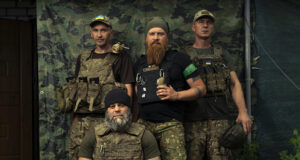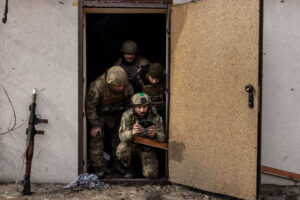Down in a bunker a little way back from the Ukraine frontline, I am watching a staple of modern warfare: a drone attack in real time.
The command centre is a small room with three TV monitors, two of which are divided into four screens. All are showing drone footage from different parts of the front’s 20 kilometres of trenches. Four men sit in front of the screens. Two men sit off at the side — one on a laptop, one manning a two-way radio. In the centre of the room stands Bereza, the Brigade commander, barking voicenotes into his phone.
Two of the screens go black and a message pops up: “Your livestream will play again as soon as it’s available. Get Ready!” I’m told it happens all the time. The screens cut in and out for all manner of unpredictable reasons. But, then, the image reappears and we are looking at a forest. A Russian tank is on the move — changing direction and wheeling around. The men inside this room are trying to destroy it. Their constant banter — about girls and weapons — doesn’t seem to affect the focus with which they pursue the tank. One man shouts into the radio; Bereza growls into his phone. A screen goes black again. “Your livestream will play again as soon as it’s available. Get Ready!”
A screen flashes with light. Then billowing smoke. The men whoop and cheer. I have just seen a successful strike. Dima grins. The atmosphere is electric but also strangely banal. The exclusively male cohort, the puerile jokes, the screens, the repeated invocation to “Get Ready!”. It’s like they are all playing a video game.
“This is modern war, David” says Dima. “The war online.”
In some respects, 21st-century warfare began the first time a US MQ-1 Predator UAV (that’s an unmanned Aerial Vehicle) drone flew over the Taliban’s positions to photograph the scene below. The Americans realised drones could be used for more than snooping. They could be modified for combat, armed with missiles and other incendiary devices. China, Iran and Turkey joined the arms race, and now they flood the market with their own cheap and effective drones.
For any state fighting without the wealth of the United States and China (which is everyone else), what is cheap and effective is also necessary. Out in Ukraine, the skies throng with Chinese-made DJI Mavics, Iranian Shaheds, Russian Orlan-10s and Turkish Bayraktar TB2s. Drones may not have the same payload or firepower as a fighter jet, but then again you can’t buy a fighter jet on the internet. For the price of one F-35, you can buy 55,000 DJI Mavic 3s. For less established militaries, drones offer the chance of levelling the field to at least some degree.
I spot a DJI Mavic 3 drone amid the scattered clothing, food and weaponry in the Dnipro 1 base. It’s not more than around 13×12 inches. This is a civilian camera drone — anyone can buy it online for around $3,000. If resource constraints breed creativity, then the Ukrainians are becoming artists. When I covered the battle of Bakhmut, an officer there explained to me how his unit could take out a multi-million-dollar T90 Russian tank by simply buying a Mavic online and fitting it with a small explosive. The Ukrainians have become masters of modifying consumer drones for conflict; of weaponising the everyday into something far more potent.
There is an atmosphere of relaxed watchfulness here. The sound of shells and rockets is distant but constant. The soldiers are fighting the Russians up close with tanks, rockets, artillery, sometimes even rifles. And always drones. Some, including the Iranian-made HESA Shahed 136 that the Russians use, are designed to directly strike targets. These are generally expensive — though the Shahed comes in at around $10,000 upwards, which makes it affordable enough to be expendable (only increasing their threat). But the Ukrainians mainly use drones as “eyes in the sky” — they use the cheaper camera ones to spot enemy targets and then call in their coordinates to other units, mainly artillery, to enable them to strike them more accurately. When ammunition and equipment stocks are low, firing must be accurate. On the front, there are few second chances.
“If I had had this technology in 2014, Putin would not have been able to occupy any of our territories. Fact,” says Dnipro 1 commander Yuriy Bereza. “The most important thing now is online comms. The most important thing is that I can see the reality on the ground.” He’s whittling a piece of cardboard with a knife, which he waves it around for emphasis as he makes his point. “When soldiers are on the front they are stressed and often give the wrong information, but with a drone I can see the situation calmly on the screen… I see the reality, the truth of it all — from above. It impacts how quickly I can make a decision. And whoever is quicker wins.
“It’s incredible how drones are changing the war. If I turn on my phone – a rocket will come out of the sky and land on me. The Russians can track it and they have orders to kill me. So many things in war now are about WhatsApp, Facetime, Signal — wars are being run out of phones. And if you leave a phone on in the wrong place you can die.”
The next morning after coffee, Bereza calls over a soldier who introduces himself as Oleksiy and who was part of the team last night. He is a studious-looking man who before the war was, like Dima, an IT engineer. Once those fighting here would have been the most physically impressive. Now they are recruited for their digital skills. Contemporary conflicts now require different types of soldiers — and they’re neither AI-generated nor Olympians.
He explains that what I had seen yesterday was part of a multi-pronged mission to stop two Russian tanks trying to destroy Ukrainians positions on the zero line while simultaneously trying to draw the unit’s attention away from an attack from the other side. “My role is to coordinate the direction of fire and to give tasks to the different units around me. Those who pilot the drone; those who analyse the coordinates; those who shoot — all of them I coordinate on the battlefield.”
He picks up a book from the table. “Look at this book on how to be a commander. It’s several years old, but we need to react to events as they are now. Military doctrine is like a computer program, it needs to be updated every six months. Drones are the best for choosing tactics, not tomorrow, but right now.”
And you need to be creative. Last night one of the tanks managed to get away but they got the other one by sending the drone up to follow it in real time and then send its coordinates to the artillery as it moved. They could direct their fire in such a way that while they didn’t hit it directly, they forced the tank onto a mine, blowing it up. The whole operation took about three minutes. How would they have done this operation without drones? “Before drones,” he replies, “the only eyes we had were of the infantry. We sucked.”
What about the air force? He smiles. “Well, for a start the Russians also have more planes. But even so, maybe you can hear a tank from a plane, but you cannot work out where it is. Especially if the tank is hidden and then two minutes later comes out of its hiding place — and the Russians use jamming systems to disguise their movements, but we use drones from a big distance to get around this. Drones allow us to watch the battle in real time.” The benefits drones bring are more than just narrowly military. For a start, there is the question of morale. One of the unit’s key tasks, Oleksiy explains, is to aid their infantry. “When they see us over their heads, [they know] we are protecting them, so they are happier to stay on their frontlines positions, because they know we can be there in one minute,” he says. This, in the end, it’s what it’s all about in war: speed. And drones, if used properly, give you that. Right now, the Ukrainians are reaping the rewards.
The Russians are neither stupid nor technologically naive. According to reports, Ukraine is losing around 10,000 drones per month to Russian electronic warfare. When I spoke to Dima earlier in the year, he told me how much better the enemy was getting at jamming and disrupting his attacks and how much more advanced they were in medium-range drones. Now, 18 months on, despite all their problems, the Russians remain in the field and they are getting better. They have significant technological capabilities — and, crucially, they are learning from their mistakes.
The Ukrainians, meanwhile, are forced to crowdfund for drones (and indeed other equipment). The Russians, bereft of international or often popular domestic support, are reliant on Moscow to keep delivering. It does so inadequately and with little concern for its own men. But its artillery is still firing, and its drones are still in the air. And as the counteroffensive intensifies all the way up and down the line of contact, it is becoming clear that whoever wins the drone wars will come to hold the upper hand in the war — perhaps for good.
Disclaimer
Some of the posts we share are controversial and we do not necessarily agree with them in the whole extend. Sometimes we agree with the content or part of it but we do not agree with the narration or language. Nevertheless we find them somehow interesting, valuable and/or informative or we share them, because we strongly believe in freedom of speech, free press and journalism. We strongly encourage you to have a critical approach to all the content, do your own research and analysis to build your own opinion.
We would be glad to have your feedback.
Source: UnHerd Read the original article here: https://unherd.com/



